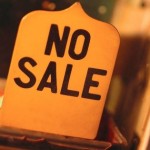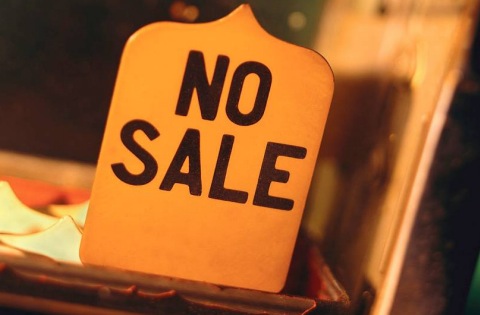Everyone knows there is a huge gap between what customers do and what they say they will do. This is the single, most important reason why focus groups are inherently unreliable in predicting the commercial success of an ad, idea or product. And British Airways knows this better than most as this one simple mistake – of believing what customers said they might do – meant they had to throw away thousands of dollars worth of fresh produce.
Several years ago, someone in the marketing department at British Airways had a crazy idea. He thought it might be a great idea to introduce a private, fully stocked mini-bar in the first class cabin. British Airways of course conducted lots of focus groups to find out what their customers would most likely want when they woke up in the middle of the night craving a snack. The research was pretty clear – fresh fruit and healthy snacks like salads were the most sought after.
The cabin crew were sceptical when they heard about the health conscious proposal and one experienced stewardess was very vocal in her critique. So much so, that British Airways agreed to her suggestion that they also add a selection of chocolates and cakes to the mini-fridge. Perhaps not surprisingly, when the first planes to stock the self-serve mini-bars touched down and were checked and re-stocked by the ground crews, an interesting truth came to light. Without fail, the cakes and chocolates had been devoured but all of the salads and fruit were left untouched.
Do you know why?
The answer lies in the way that our brains are hard-wired.
Neuroscience has proven that there are many distinct parts of the brain and each of them performs a different function. However, only 1 of them is responsible for decision making and it fires up long before you are consciously aware that you have made a decision.
The biggest part of brain – the neo cortex – is where you think and reason. So when your customer says “I need to think about it” or “is this the best price I can get?” this part of the brain is firing up and looking for data. Not surprisingly, this part of the brain reacts slowly and uses up tons of your body’s energy – in order to keep you safe and alive, the body is hard wired not to rely on the thinking part of the brain to assess and evaluate all the data and information.
At the top of your spinal cord, there is a collection of neurons – which are commonly referred to as the old or reptilian brain. It is your fight or flight brain – and its sole responsibility is to ensure your survival. It’s the part of the brain that lights up when you DECIDE.
It lights up even before you have conscious awareness that you have made a decision. Now, while it is very true that this is the most primitive part of your brain, the good news is that it is very predictable. By understanding how this part of your brain works, you will discover why you should never offer your customers fruit when what they really crave is chocolate.
The old or reptilian brain of your customers is an automatic mechanism – it does not think, it only DECIDES and ACTS. It is always at work scanning the environment looking for information of value to his survival.
So how does this apply to your customers and your product/service?
Just for a moment, I want you to imagine that you are in the business of selling pizza. Now, it doesn’t matter whether you are Pizza Hut, Dominos, Eagleboys, or Pizza World… you’re basically selling a commodity and the market looks fairly price conscious, doesn’t it? The reason for that is simple – the consumer finds it hard to distinguish between your pizza and the next guy’s.
In your mind, you might think yours is better because your crust is thicker and you provide more toppings and value. But in the eyes of the consumer, your pizza isn’t really worth much more than your competitor’s. Why is that?
Even though you think there is a difference, in the eyes of your customer, there isn’t. 95% of what you and the next guy offer are essentially the exact same thing. And as long as you keep operating in that zone with a marketing message that doesn’t stand out and stake a claim, you will continue to compete on price because your message forces your customer to think too hard and evaluate all the options.
So knowing this, what could you do differently?
In 1973, one company identified a way to stand out and grab market share in this highly competitive market. It didn’t claim to have the best, the thickest crust or even the cheapest pizza, it just made you a promise that if you ordered from them, you would get it in 30 minutes or your pizza was free. It was the most successful campaign in the history of the industry – for good reason.
Think about it, when you order a pizza, what is the #1 burning question that you have in the back of your mind? —– “I wonder when the pizza will get here?”
Dominos answered that question for you. They didn’t offer fruit when all you really wanted was chocolate. Their offer, which was different from everyone else’s, solved your #1 source of pain, didn’t make you think too hard and it triggered the part of your brain that decides and dials.
This is the power of Sales Seduction – understanding why your customer says YES and helping him to say YES to your product/service. When you discover “what the chocolate is for your specific customers and prospects”, you will accelerate your sales process, close more business, trigger decisions and be able to charge a premium price for your product/service.
Spend some time today to identify how you might be offering fruit instead of chocolate and therefore, boring or overwhelming your prospects. The key to offering what they really want, is in identifying the # 1 source of pain and proving that your solution will cure it today!
Do you already have more customers than you can handle? I thought so. I haven’t met a business owner yet who was willing to turn away more customers or sales.
So if you wanted to find more qualified leads and customers right now… how would you go about doing it?
Now, most of you have already begun to evaluate which marketing vehicle is going to be best:
- Should you use social media?
- What about a letterbox drop or telemarketing?
- How about another ad in your local newspaper?
And truth be told, there are a hundred ways that you could get your name or brand out there. But all of these would cost time or money and history has proven that most of the options that you have relied on to date will produce less than a 1-2% conversion rate. That means there are an awful lot of people out there who will see your message and choose not to contact you, even though some of them may legitimately be in the market for your product or service.
Why is that?
You know (or least you suspect) that a large percentage of your sales/marketing budget is not effective and simply doing more of what you have always done (or what everyone else in the industry is doing) isn’t going to improve your results significantly. If you want to influence with integrity, attract more customers and increase your sales exponentially, you need to re-think your entire approach and strategy.
Not now but in a moment, I would like to share with you a little story about how a very clever (and effective) salesman used some broken glass to communicate his point of difference and outsell every salesperson in his company…
But before I get to that, let me ask you one question – “have you ever come across one of those rare business owners who sells exceptionally well, even during the worst of times?” These super salespeople sell like crazy — rain or shine — and they don’t experience slow days, weeks or months. And what’s even more impressive – they make it look effortless, don’t they?
Do you know why? Because it is easy for them – they have mastered the art of influencing with integrity and they don’t have to worry about closing techniques, reframing objections, rapport building or establishing their credibility.
Let me share with you a quick story that will explain exactly what I mean by influencing with integrity and how it can help you to achieve phenomenal results in your business. In the 1970’s, Corning Glass introduced an innovative product, safety glass, into the North American market.
A young salesman with little experience joined the company shortly thereafter and began working his way up through the sales department at a feverish pace. In very little time, this young man named Bill, became the top-selling salesman of safety glass in North America. He stunned management with his rapid achievements and became known for refusing to use the standard templates and presentations that most of the other salesmen relied blindly upon. At the national sales convention, he was given an award for his achievements and asked by the president to share his secret to sales. Everyone seated in the room that night waited on the edge of their seats to discover just how this young man, with no prior sales experience, was able to outsell everyone.
To the president’s invitation, he replied humbly, “of course, it was simple.”
“First of all,” he confessed “I commissioned some samples of safety glass cut into 6” squares and I purchased a hammer and safety goggles. Rather than boring my audience with small talk, a background summary or building up my credibility, I would simply walk into the room, greet my prospect and open with the question “Would you like to see a piece of glass that doesn’t shatter?”
And I never met a single one that turned me down. In fact, they were all eager to take part in my little experiment and jumped at the chance to pull on the safety goggles, put the glass on the desk and whack it with the hammer. They loved every minute of it and inevitably when they couldn’t break it, they would take the goggles off, sit back in their chairs and exclaim “’Holy smoke, that’s incredible!”
“Then I would simply say,” as Bill paused strategically and drew the adoring crowd in closer for more of his wisdom, “How much of it would you like? And I’d pull out my order pad and start writing up the order.”
Well as you can imagine, Corning Glass was so impressed with this strategy that they equipped all of their salespeople with goggles, hammers and small sample sheets of glass. They sent them out and found that the average closing rate shot up by almost 29%. Now granted, this specific strategy is ideally tailored to work for selling safety glass and it’s not going to work (without some modifications) to get more customers to buy from you.
But my point (and what you need to take away from this example) is this: The top salesman at Corning never had to “close” the sale, discount his price or resort to Neuro Linguistic Programming (NLP) techniques of matching and mirroring to create rapport. His presentation cured the #1 source of pain for his prospects upfront, so there was no need for him to close, hard sell or waste anyone’s valuable time. The sale was a done deal even before Bill pulled out his order pad.
Now, let me ask you: How would your life change if you could attract more customers and close them that way everyday — where leads are drawn to you quickly and closing is just a formalitythat you no longer need to dread?
Surprisingly, the dilemma you face right now in attracting more customers has a whole lot more in common with Bill and his story than you might think. You and I say “Yes” to things every single day before we think them through. I want to share with you WHY that is and what compels you to decide and take action. And in the process you will also unlock the secret to transform your message into one your prospects are dying to say “yes” to.
Understanding Why Customers say “Yes”
While each of the distinct parts of your brain are constantly communicating with and influencing each other, each performs a very specific role. And as you might suspect, only one of them is responsible for decision making. Neuroscientists have now successfully mapped and measured which areas of the brain light up when stimuli are processed and decisions are made.
So when your prospect says, “I need to think about it,” we know that the part of the brain that your message is triggering is the new brain. This part of the brain lights up when you are processing words, numbers, colours, making spatial comparisons, or looking for data. In a nutshell, it THINKS and when it does so, it uses up tons of energy—which delays the decision making process.
Now thinking may not seem like a big deal to you but it is for your brain. Your brain consumes 25% of your body’s total energy. Because of this extraordinary consumption, your brain is hardwired to conserve energy when and where it can. One of the ways it does this is to NOT rely on the thinking part of your brain to make decisions. From a survival perspective, the brain doesn’t like to use more energy than it has to. Therefore, if you can make it easier for your customer’s brain to grasp your message, process it quickly and decide, you are more likely to get a “Yes”.
If you want to drag out the process of getting to a decision, make sure that he uses his new brain. Give your audience lots of words, numbers, graphs, lists of features and benefits, talk about your competition, and list all of your awards and accreditations—and your customer will NOT decide but he will do a whole lot of thinking and waste time.
So where do you decide?
At the top of your spinal cord, there is a collection of neurons—commonly referred to as the old (or reptilian) brain. All bodily functions that take place below the level of consciousness emanate from this part of your brain and it is the part of your brain that lights up when you DECIDE. In fact, it lights up before you have conscious awareness that you have even made a decision because it “sees” things as much as 500 milliseconds faster than the new brain.
In order to help your prospects use the least amount of brain energy and trigger a quick decision, you must stimulate and appeal to the old brain. This part of the brain is primarily driven by visual cues and primitive instincts. It is 45,000 times older than language and writing and neuroscience has proven that it struggles to process both.
In order to influence with integrity you need to learn how to trigger the old brain quickly so that when the thinking part of the brain kicks in, your prospect spends time looking for reasons to justify why he has already decided to buy from you – as opposed to reasons why he can’t or needs to think about it.
In order to do what Bill did naturally and help your prospects to say “Yes” (more quickly) to your product or service, you must first learn to speak the language of the reptilian brain. Without this skill, all of the other strategies and tactics that you have learned in your sales training so far are of no use to you.
And the best part about this is that you do not need to compromise your integrity or your ethics to improve your results. You don’t need to fall into the trap of feeling that you must hard sell your audience, make your message elaborate, spend more money putting it out there, or use tactics that are designed to trick people into deciding now.
Here are My Top 7 Secrets to Make This “Broken Glass” Strategy Work for You
- Quit Using Templates – Stop trying to find prospects with the template newspaper ads, letters, postcards and fridge magnets your competitors are using. People do business with people they like and who are like them. Connect with people and demonstrate you understand their pain and can solve it.
- Capture attention upfront – In order to stand out and be remembered, you need to open with a question, story, or picture that is relevant to your audience.
- Stop wasting time on you – Never waste your time telling potential customers about you or your brand. 100% of your message should focus on your prospect and how your solution will cure her pain, keep her safe, or make her life better.
- A picture is worth 1000 words – Your brain is hardwired to process visual cues and act before you have time to think things through carefully. If you want more customers sales, you need to get rid of words, graphs and statistics and demonstrate how their life will be better with your solution.
- Simplify your message – The brain can only process and memorize 3 or 4 key points at a time. If your message is more complex than that, it simply will not be remembered.
- Use stories to communicate your key points – Messages that cause your customers to reconnect with or rediscover strong emotions from their past and associate those with your solution, are 10x more likely to trigger the part of the brain that decides.
- Crank up the contrast – In order to trigger a decision quickly and increase sales, you must stand out. Your customer needs to feel the difference between your solution, your competitor’s solution, doing it themselves, or doing nothing.
These 7 steps will help you increase the effectiveness of your message and reduce the amount of time and money that you spend chasing more customers and sales. When you make it easier for your prospects to see and grasp your message, they are more likely to decide and will appreciate the fact you have not wasted their time and energy on stuff that is important to you, but not them.
01 Nov 2013
3 Signs You Are About To Lose The Sale
 Like most of you, I get cold calls and e-mails every day. 98% of it is spam – offers for things I have no interest in, or don’t need. Only 2% are even relevant to me or my business and unfortunately, most of those don’t get my attention either (so they inadvertently lose the sale).
Like most of you, I get cold calls and e-mails every day. 98% of it is spam – offers for things I have no interest in, or don’t need. Only 2% are even relevant to me or my business and unfortunately, most of those don’t get my attention either (so they inadvertently lose the sale).
Truth be told, I almost never answer or respond and I’m sure you feel the exact same way. It’s not because I have it in for salespeople – although most of us will admit we cringe at the hard sell tactics of the stereotypical salesperson. It’s because the vast majority of salespeople completely blow their initial approach and fail to capture my interest.
Now I appreciate and respect the fact that these people are just trying to do their jobs and make a living. Selling is not a crime. In fact, we are ALL in the business of selling something – a product, a service, an idea, a lifestyle, a belief, or a cause. So, like you, I’m not insensitive to the plight of the honest, hardworking sales professional.
The problem is this – most of their hard work (and yours) often goes to waste when they lose the sale for reasons that are preventable. They end up turning me off their product or whatever it is they’re selling because I am either bored, confused or overwhelmed by the pitch. And this usually shows up in one of three classic responses that I give, which I’m sure you have heard (or given) before. These are telltale cues that they (or you) are about to lose the sale:
- This isn’t a good time for me,
- I need to think about it, or
- Leave it with me and I will go over it later.
Fortunately, the mistakes that produced these 3 classic responses are completely avoidable – mistakes that you don’t have to make (and lose the sale) once you discover how the brain of your prospect hears your message and what you need to do to help him make a decision quickly.
The first and most important step in creating a sales or marketing message that closes more business is to become an expert at capturing attention up-front. If you are successful at quickly and strongly enchanting your prospect within the first 60 seconds, you stand a much greater chance of holding his interest until you can communicate your entire message.
Regardless of the length of your sales presentation or marketing message, you must capture attention and deliver your most powerful points up-front when your audience is most alert and receptive. Never begin by introducing your brand, building your credibility, talking about your competitors, or listing features and benefits. This strategy will put your customers to sleep (cause you to lose the sale) and you risk having to deliver your most important claims and proof when your customers are least likely to remember them.
In order to capture the attention of your audience and hold it, you have to know the one thing that is MOST important to them right now. This is something that you cannot afford to guess or assume. In order to make the greatest impact and charm the old brain of your customer, you need to do your homework up-front. You can’t afford the luxury of pitching five or six features/benefits and hope that one of them will appeal or hit the mark.
By taking the time upfront to help your prospect understand, acknowledge, and quantify his #1 source of pain, he will become clear about the true source and intensity of this problem, and you will reinforce (with his old brain) that it is safe to trust you and your proposed solution. Failing to do so, will inevitably lead to the undesired result of causing you to lose the sale and waste your valuable time and money in the process.
 Although you may like to think you are creatively captivating your consumer with your communications, allow me to drop a mind-blowing bomb… Did you know that your current marketing messages are falling on the deaf ears of approximately 98% of your prospects?
Although you may like to think you are creatively captivating your consumer with your communications, allow me to drop a mind-blowing bomb… Did you know that your current marketing messages are falling on the deaf ears of approximately 98% of your prospects?
Read More
04 Sep 2013
Top 10 Ways to Find Customers Online
 Do you like it when people you don’t know call you up and try to sell you stuff? I thought not.
Do you like it when people you don’t know call you up and try to sell you stuff? I thought not.
Cold calling is one of the most costly and difficult ways to find customers. Not only is it time consuming, but it can actually turn customers off to your business. And why would you do it when there are numerous, more effective, online options available to find customers and drive thousands of qualified leads to your business today?














